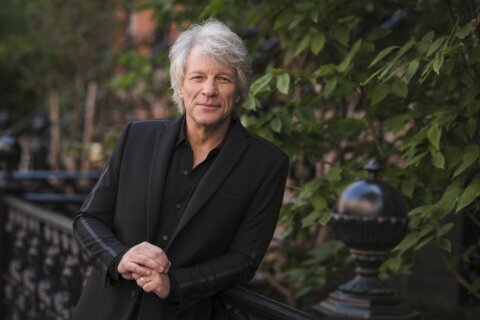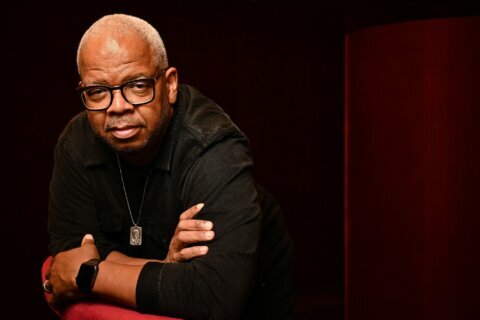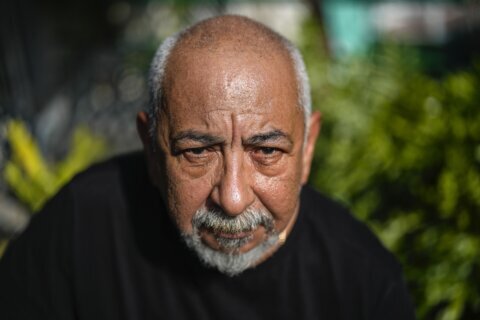WASHINGTON — It’s arguably the greatest American play ever written.
Now, Edward Albee’s “Who’s Afraid of Virginia Woolf?” rocks Ford’s Theatre through Feb. 19.
“It’s scarily relevant, a 55-year-old play,” actor Gregory Linington told WTOP. “There’s times I don’t even feel like I’m acting, because I’m speaking his words, but they’re some of my opinions as well.”
Born in D.C. in 1928, Albee was expelled from multiple schools as a kid before leaving Trinity College in 1947 to pursue writing. His first popularized work, “Zoo Story,” premiered in Germany in 1959 and played off-Broadway in 1960, before his Broadway debut “Virginia Woolf” arrived like a thunderclap in 1962, winning the Tony Award for Best Play, followed by three Pultizer Prizes from 1967-1994.
“It was written by this relatively young man, at that period, and yet the things that he touches upon are still so applicable to our lives,” actress Holly Twyford told WTOP.
The play follows George (Linington), an associate professor at a liberal arts college in New England, and his brash, alcoholic wife Martha (Twyford), daughter of the college president. After a faculty party, Martha invites two young colleagues over for a 2 a.m. after party: hotshot new professor Nick (Danny Gavigan) and ditsy wife Honey (Maggie Wilder), who’s a “mousy little thing without any hips.”
“It’s about a very particular night in George and Martha’s home when a lot of earth-shattering understandings and long-held illusions and beliefs are shattered,” Twyford said. “In some ways, the guests are catalysts and sometimes they’re an audience for George and Martha’s fun and games.”
In fact, “Fun & Games” joins “Walpurgisnacht” and “The Exorcism” as the titles of the play’s three-act structure, each lasting an hour that moves so fast it feels like 20 minutes. Of course, the characters have their own names for each act: “Humiliate the Hosts,” “Get the Guests” and “Hump the Hostess.”
“Games are a huge theme in the play,” Twyford said. “The first act is called ‘Fun & Games’ and later in the third act, I say something about George being able to keep up with the games that we play, even as I change the rules constantly. That is an important aspect and also speaks to illusion and not being in real life. ‘We’re just playing a game!’ But of course, there are games rooted in rather ugly realities.”
“You think there are no rules in this relationship, no-holds-barred, people beating the hell out of each other all the time. It’s not true,” Linington said. “There are Rules of the Game that, when transgressed, other games need to be played. So if she’s changing the rules, then he needs to find a new way to play.”
This one-upmanship is filled with acerbic wit fueled by repeated booze refills at the living room bar.
“This play is so funny,” Twyford said. “He’s a great comic writer. There’s just some great one-liners. They’re usually zings. … It’s not insult comedy, but it’s a version of it that is very American. The banter is so illustrative of their marriage. It’s so clear they’ve been together 23 years having vocal sparring matches. You know exactly where to go, and also know when to lay off, although that doesn’t happen often on this night. We think, ‘Am I gonna rise to that? No, I’m not. Could you get me a drink?'”
“They’re both the two most brilliant people who have ever been put on a page,” Linington said. “I’ve never played anybody as smart or as quick, [saying], ‘We’re walking what’s left of our wits.’ I think of Don Rickles all the time. … Relentless! It’s like they’re parenting each other all the time. … They go back and forth between lovers, best friends, mother and father. There’s a constant shifting with that.”
While the marital sparring is side-splittingly hilarious, it lures us into the heavier, underlying themes.
“I think it’s a way of opening us up,” Linington said. “I always feel very exposed as an audience member when I’ve been laughing. It just allows that knife to slide in under the ribs and getcha!”
Indeed, the play cuts like a knife, exposing a crumbling marriage coming to a drunken head.
“I don’t think that I necessarily choose that tonight’s the night the band-aid comes off; it’s much more of a developing night,” Twyford said. “I have seen clear as day something that I’ve known for years: that he’s never gonna be what I want him to be. And not only what I want him to be [for me], but what I want him to be for him, which is the most important nuance. … I say, ‘Okay, you have let yourself down completely and that’s how you’ve let me down.’ It’s like a crack in the universe that happens.”
The ultimate weapon in this “crack” is a deep, dark secret shared by the couple. We won’t reveal what that secret is — come see the play! — but to avoid spoilers, let’s just say that illusions are shattered.
“Ultimately, that’s what Martha’s afraid of,” Twyford said. “For the past 23 years, for their entire marriage, she’s been living in a little bit of a make believe that I don’t think she can live without.”
George is partly to blame for fostering this illusion.
“He’s absolutely complicit, but with the understanding that it’s always something that is intensely, intensely private, this illusion that we’re living in,” Linington said. “The things that happen inside of a marriage are meant to happen only for those two people, and when some of those things are revealed to other people [in this case Nick and Honey], intense, as they say, ‘acute embarrassment’ can occur.”
The cause of this secret is exacerbated by the time period in which the play is set, as 1962 New England is fertile ground to expose the dark underbelly of an idealized, white-picket fence America.
“It’s right before The Beatles, before Kennedy was killed, Vietnam,” Linington said. “It has a ’50s mentality. As you encroach into a new decade, you’re holding onto the vestiges of the old. The ideal would be: These people are fine. The younger couple is fine. They might be a little liberal and might drink too much, but who doesn’t? Then as more of the onion is peeled, you get down to the [truth.]”
Set designer Meghan Raham taps into this by showing a cross-section of George and Martha’s home.
“You see a house and it’s as though the house is cut in half,” Twyford said. “You see the insides of the walls, you see the insulation, and you see all this cutaway stuff. It’s as though, on the outside, the house looks like any normal house and everything’s fine. But as you cut into it, there’s this underbelly, this ‘under-rumbling’ — as Aaron Posner our director would say — of what is really going on.”
The design parallels what Albee once said, “I like to hold a mirror up to the people and say, ‘Hey, this is the way you behave. This is who you are. If you don’t like what you see, maybe you should change.”
Albee’s mirror is double sided, reflecting a theme found right in the play’s title, which is a clever allusion to illusion. It takes the popular children’s ditty “Who’s Afraid of the Big Bad Wolf?” from Walt Disney’s cartoon “Three Little Pigs” (1933) and inserts the realism of English author Virginia Woolf.
“I didn’t understand this until I was talking to a friend of mine who’s a very, very smart professor,” Twyford said. “She was talking about Virginia Woolf … how anti-illusion she was. In my script, I’ve cut out these quotations from various books of hers about illusion, that we need to live in reality.”
Like most strokes of genius, Albee’s clever title happened completely by accident.
“It wasn’t the original title of the play,” Linington said. “He apparently had seen this as a piece of graffiti on a wall — ‘Who’s Afraid of Virginia Woolf?’ — and then he wrote it down in a notebook.”
“Thank God he didn’t call the play, ‘For a Good Time Call,'” Twyford joked.
But as Simon and Garfunkel sang, “The words of the prophets are written on the subway walls.” So when filmmaker Mike Nichols used that line to kick off “The Graduate” (1967), it was fittingly just a year after his directorial debut “Who’s Afraid of Virginia Woolf?” (1966). Starring Richard Burton and Elizabeth Taylor, the film won five Oscars as one of the American Film Institute’s Top 100 Movies.
“I became obsessed with watching all of Nichols’ films and this was number one on the list,” Linington said. “Amazing performances, of course, from the entire cast in that film. I also saw a performance of [the stage version] at the Oregon Shakespeare Festival, where I worked for many, many years.”
“I’ve seen it performed [on stage], but I don’t think I’ve ever seen the whole film,” Twyford added.
“Oh, we should watch it!” Linington said. “We should watch it when we’re done!”
Perhaps it’s fitting that Nichols and Albee passed away just two years apart, Nichols in 2014, Albee in 2016. Their legacies remain intertwined through this touchstone work that has inspired so many.
“Mamet, Sorkin, any of these muscular, male writers owe so much to him,” Linington said. “He comes from a classical background, but also this Dadaist, wackier background because he was friends with Beckett. There’s exchanges in our play that could’ve come out of Shakespeare [or] Beckett. … I did not know how good this play was … [but now] I have such an intense level of respect for the mastery.”
That mastery is not lost on the audience, who will walk out of Ford’s feeling emotionally alive.
“A friend of mine came [and] was standing with this odd expression.” Twyford said. “I said, ‘Are you OK?’ And she said, ‘I’m great! I feel energized and rejuvenated!’ I’m thinking, ‘Wow! You just saw a three-hour play with some horrific moments.’ She said, ‘It was such an incredible piece of theater! It did what theater is supposed to do.’ … That catharsis is something, and boy, could he write that! Holy moly. There’s some really great playwrights, but to take somebody on a roller coaster like that? Wow.”
Click here for more info. Listen to the full conversation with Gregory Linington and Holly Twyford below:








